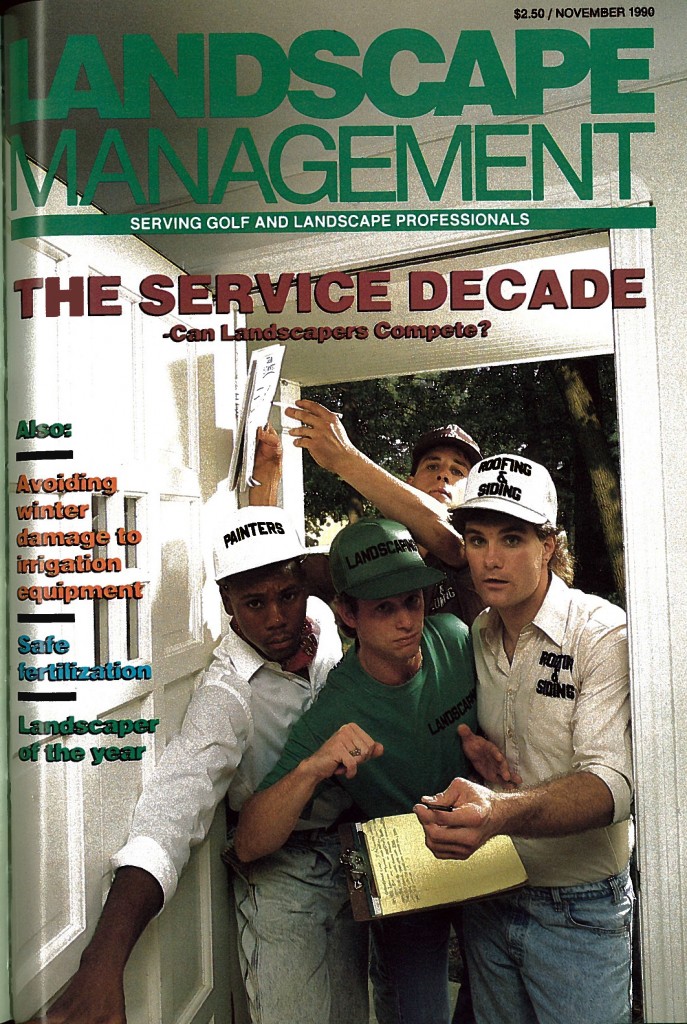 Like glimpsing into a crystal ball, the cover story from the November 1990 issue of Landscape Management foreshadows what the Green Industry had to be concerned with in the decade ahead.
Like glimpsing into a crystal ball, the cover story from the November 1990 issue of Landscape Management foreshadows what the Green Industry had to be concerned with in the decade ahead.
Whether the crystal ball was broken or not, I leave you to decide.
Titled “The service decade” by Rudd McGary, the then-senior consultant at Columbus, Ohio-based AGMA touched on three trends landscape professionals should keep on their radar in the ’90s.
Demographic issues
Point your fingers at the baby boomers for troubles in the ’90s, McGary said.
By 2000 that demographic would be 35 to 54, an age they’d be or be becoming homeowners.
The problem: In 1990, an up-and-coming housing trend was to have larger interior spaces rather than outdoors spaces, McGary said. Less yards, of course, means less need for landscaping. Which brings McGary to advise, “The Green Industry needs to look at more services than simply lawn care since the space to care for will probably be smaller.”
Look no further than LM’s Add-On Biz stories for proof that landscaping companies, in fact, have branched out their services.
Another way to combat the slump in residential work, McGary said, was to pick up more commercial accounts.
Government involvement
McGary touched on how government regulations were expected be pervasive in the decade.
Foremost, state regulations were expected intensify, primarily for herbicides and pesticides, because under the Reagan presidency much governmental power was shifted to state levels.
Secondly, licensing was expected be stricter for handling and usage of materials due to rallying from interest groups.
Lastly, there would be a rise in environmental concerns. “This trend is almost certainly irreversible,” McGary said. “If you want to cope in the future, you must be prepared to do so in a more restrictive atmosphere.”
What the consumer wants
Consumers feel “not very good” about service, McGary said, referencing an AGMA consumer survey.
According to the survey, 80 percent of consumers also were “very concerned” to “extremely concerned” about using safer products and techniques on their properties. Moreover, most respondents said they wanted to know what was being used on their lawns, period.
Only 11 percent of that 80 percent, however, said they’d accept an increase in price for heightened safety.
The solution, McGary said, was to improve customer communication.
“It is no longer acceptable to simply do a good job; you must let the consumer know what is happening when—and even before—it happens,” McGary said. “If companies can’t communicate in a variety of situation there’s almost no chance of survival.”
To that end, professionals must be observant that consumers are allocating funds to several services, McGary said.
“At its base, the Green Industry needs to understand that it is not an essential service, but that without it the environment around use will fail to be as well as taken care of,” McGary said. “Competition for the consumer’s dollar takes place not among companies but in the consumer’s mind. And the quicker your marketing people note this, the better off the company will be.”
He wrapped up with a daunting question, “Can the Green Industry take advantage of these new patterns or will it become the railroad industry of the future?”
It’s fair to say the Green Industry hasn’t become the “railroad industry of the future”—at least not over the past two decades.
Do tell me, though. Could it?

